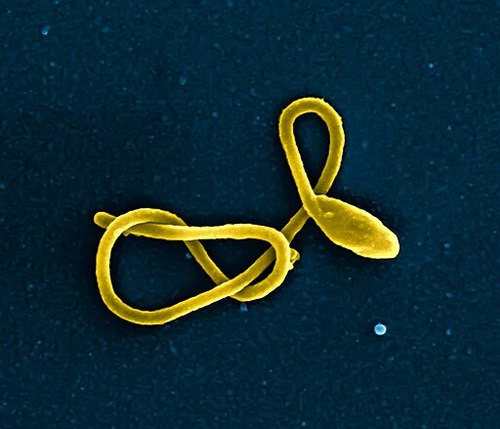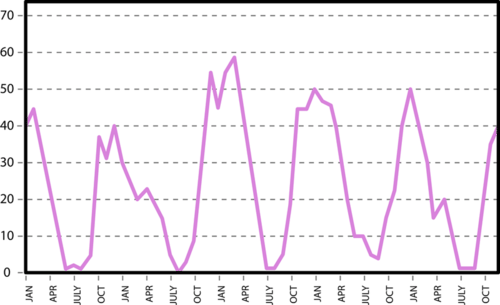11.29 病毒性疾病 -- -- 先进
章节大纲
-
How does a cause disease?
::如何造成疾病?If a spends time and energy replicating a viral genome , transcribing and translating viral , and assembling viral particles, is it involved in maintaining ? What if the host cell is destroyed by lysis? The answers to both of these questions is that the actions of the virus on the host cell disrupts homeostasis.
::如果花时间和精力复制病毒基因组、翻译和翻译病毒以及收集病毒粒子,它是否参与维持?如果宿主细胞被解剖摧毁了呢? 对上述两个问题的答案是,宿主细胞的病毒行为会扰乱主机细胞的恒定状态。Viruses and Disease
::病毒和疾病One main reason to study viruses is the fact that they cause many important , including the common cold, influenza , rabies, measles, many forms of diarrhea, hepatitis, yellow fever, polio, smallpox, and AIDS. Plant viruses can cause losses in food and crop production. Some viruses, known as oncoviruses, can lead to certain forms of . The best studied example of an oncovirus is the association between Human papillomavirus (HPV) and cervical cancer .
::研究病毒的一个主要原因是,它们造成许多重要因素,包括常见的寒冷、流感、狂犬病、麻疹、多种形式的腹泻、肝炎、黄热病、脊髓灰质炎、天花和艾滋病。植物病毒会给粮食和作物生产带来损失。一些被称为肿瘤病毒的病毒可以导致某些形式的肿瘤病毒。研究最好的肿瘤病毒例子就是人类乳头瘤病毒(HPV)和宫颈癌之间的联系。Viruses and Human Disease
::病毒和人类疾病Examples of common human diseases caused by viruses include the common cold, the flu, chickenpox, and cold sores. Serious diseases, such as Ebola, AIDS, and avian influenza, are also caused by viruses. The specific binding between the viral capsid proteins and specific receptors on the host's cellular surface determines the host range of a virus. For example, the human immunodeficiency virus (HIV) infects only human T cells because its surface protein interacts with protein receptors on the T cell's surface.
::病毒引起的常见人类疾病的例子包括普通的寒冷、流感、天花和寒痛,诸如埃博拉、艾滋病和禽流感等严重疾病也由病毒造成。病毒将病毒带入病毒,将病毒带入寄主细胞表面的病毒卡皮蛋白和特定受体具体结合,决定病毒的宿主范围。例如,人体免疫机能丧失病毒(HIV)只感染人类T细胞,因为其表层蛋白与T细胞表面的蛋白受体相互作用。As you have already learned, viruses can cause disease in a number of different ways, one of which is by cell lysis. Other viruses can cause disease without killing the host cell. Although viruses can disrupt homeostasis, causing disease, they may also exist relatively harmlessly within an organism .
::正如你们已经学到的,病毒可以以多种不同的方式造成疾病,其中之一是细胞解剖。 其他病毒可以不杀死宿主细胞而导致疾病。 尽管病毒可以扰乱顺势,造成疾病,但病毒也可能在生物体中相对无害地存在。An example of a harmless existence is the of the herpes simplex virus. This virus causes cold sores, and it can remain in a dormant state within the , a period of time called latency . Latency is also a characteristic of the varicella zoster virus which causes chicken pox. Latent chickenpox infections return in later life as the disease called shingles. Shingles is characterized by a painful skin rash with blisters in an area on one side of the body, as shown in Figure . It results from the reactivation of the latent varicella zoster virus that lie dormant in nerves .
::一种无害存在的例子就是除草虫病毒。这种病毒造成寒痛,在被称为潜伏期的一段时间内,它可能处于休眠状态。延缓也是导致水稻天花的稀有动物病毒的特征。迟缓的天花感染在晚年恢复,称为闪烁。如图所示,闪烁的特征是身体一侧的一个区域有痛苦的皮肤皮疹,充斥着泡泡。它产生于神经休眠的潜伏性寄生动物病毒的恢复。Shingles (herpes zoster) outbreak across the neck and face. It is caused by a reactivation of the chicken pox virus (Varicella zoster) that has laid hidden in nerve cells since the person had chicken pox. In this man’s case, the viruses emerged from nerve endings in the neck. You cannot “catch” shingles from a person with the shingles rash, but you could catch chickenpox from them, unless you have been vaccinated against chickenpox. Some viruses can cause life-long or chronic infections where the viruses continue to replicate in the body despite the hosts' defense mechanisms. A chronic infection or disease is long-lasting and happens again and again. Hepatitis B viruses and Hepatitis C viruses cause chronic infections. People chronically infected with Hepatitis B virus are known as carriers, who act as reservoirs for infectious viruses, passing them onto other people.
::有些病毒可能导致终生感染或慢性感染,病毒尽管有宿主的防御机制,却继续在体内复制。慢性感染或疾病是长期的,并且一再发生。乙型肝炎病毒和丙型肝炎病毒造成慢性感染。长期感染乙型肝炎病毒的人被称为携带者,他们充当传染性病毒的储存库,传给其他人。The Flu
::流感Influenza, or the flu, spreads around the world in seasonal epidemics . An epidemic is an outbreak of a disease within a of people during a specific time. Every year in the United States, about 200,000 people are hospitalized and 36,000 people die from the flu. Flu pandemics can kill millions of people. A pandemic is an epidemic that spreads through human populations across a large region (for example a continent) or even worldwide. Three influenza pandemics occurred in the 20th century and killed tens of millions of people. Each of these pandemics was caused by the appearance of a new strain of the virus. Most influenza strains can be inactivated easily by disinfectants and detergents.
::流行性流感,即流感,在季节性流行病中蔓延到世界各地。流行病是一种在特定时间内在某一人群中爆发的疾病。在美国,每年大约有20万人住院治疗,36 000人死于流感。流感可以杀死数以百万计的人。流感是一种流行病,在广大地区(例如一个大陆)甚至全世界蔓延。三种流感流行病发生在20世纪,造成数以千万计人死亡。每一种流行病都是由一种新的病毒菌株的出现造成的。大多数流感菌株很容易通过消毒剂和洗涤剂来消毒。Influenza (commonly called the flu) is a contagious respiratory illness caused by influenza viruses. Influenza usually starts suddenly and may include the following common symptoms:
::流感(通常称为流感)是流感病毒引起的传染性呼吸道疾病。-
Fever (usually high).
::发烧(常高) -
Headache.
::头痛 -
Tiredness (can be extreme).
::疲劳(可能是极端的)。 -
Cough.
::咳嗽 咳嗽 咳嗽 咳嗽 咳嗽 -
Sore throat.
::喉咙痛 -
Runny or stuffy nose.
::跑步或闷闷的鼻子。 -
Body aches.
::身体疼痛。 -
Diarrhea and vomiting (more common among children than adults).
::腹泻和呕吐(儿童比成年人更常见)。
Many people who have a stomach problem refer to it as the "stomach flu," which, medically speaking, does not exist.
::许多胃部有问题的人称之为“胃道流感”,从医学上讲,这种流感并不存在。HIV
::艾滋病毒/艾滋病毒Most researchers believe that the human immunodeficiency virus (HIV) originated in sub-Saharan Africa during the 20th century. is transmitted by sexual contact and by contact with infected bodily fluids, such as , semen , breast milk, and vaginal secretions. It is also passed from mother to fetus . HIV is now a pandemic, with an estimated (as of 2008) 38.6 million people now living with the disease worldwide. It is estimated that AIDS has killed more than 25 million people since it was first recognized in 1981. is further discussed in The Immune System : HIV and AIDS (Advanced).
::多数研究人员认为,人体免疫机能丧失病毒(艾滋病毒)20世纪起源于撒哈拉以南非洲。通过性接触和接触感染的体液(如精液、母乳和阴道分泌)传播,还从母亲传染给胎儿。艾滋病毒现在是一种流行病,据估计(截至2008年)全世界有3 860万人感染了这一疾病。据估计,自1981年首次承认艾滋病以来,已有2 500多万人死于艾滋病。《伊蒙系统:艾滋病毒和艾滋病》(Advanced)对此作了进一步讨论。HIV is a retrovirus that destroys the human immune system. HIV primarily infects helper T cells (specifically CD4 + T cells), macrophages, and dendritic cells. HIV infection leads to low levels of CD4 + T cells because the virus directly kills infected cells, and the infected T cells are also attacked by the immune system. The infection of a CD4 cell is shown in Figure . When CD4 + T cell numbers decline below a certain critical level, cell-mediated is lost, and the body becomes more prone to opportunistic infections.
::艾滋病毒是一种破坏人类免疫系统的反转病毒,艾滋病毒主要感染了帮助T细胞(特别是CD4+T细胞)、大型动物和登地细胞。艾滋病毒感染导致CD4+T细胞的低水平,因为病毒直接杀死受感染的细胞,感染T细胞也受到免疫系统的攻击。CD4+T细胞的感染在图中显示。当CD4+T细胞数量下降到某一临界水平以下时,细胞中介就丢失了,身体更容易受到机会性感染。If left untreated, most HIV-infected individuals will develop Acquired Immunodeficiency Syndrome (AIDS). AIDS is a collection of symptoms and infections resulting from the damage to the immune system by HIV. Because the immune systems of people with AIDS are so weak, and viruses that do not normally cause disease in healthy people can easily cause disease in an AIDS patient. Opportunistic infections associated with AIDS include:
::艾滋病是艾滋病毒对免疫系统造成破坏的症状和感染的集合体,因为艾滋病患者的免疫系统非常薄弱,通常不会在健康的人中造成疾病的病毒很容易在艾滋病病人中引起疾病。-
Pneumocystis
pneumonia
, a form of pneumonia caused by a
.
::肺炎 肺炎 一种由肺炎引起的肺炎 -
Tuberculosis
(TB), caused by the
Mycobacterium tuberculosis
bacteria.
::肺结核(TB),由菌肺结核细菌引起的。 -
Lung
infections caused by Mycobacteria other than tuberculosis (MOTT).
::肺炎感染由除肺结核以外的麦科白菌引起的。 -
Kaposi's sarcoma
, a type of cancer that is caused by Kaposi's sarcoma-associated herpesvirus (KSHV).
::Kaposi的sarcoma是一种癌症,是由Kaposi的 sarcoma 与有关病毒(KSHV)引起的。
Lifecycle of HIV. The image at the bottom right is an SEM of HIV budding from a cultured lymphocyte. The many round bumps on the cell's surface are sites of assembly and budding of virions. Figure summarizes how HIV infects a CD4 cell.
::图概述艾滋病毒如何感染CD4细胞。-
First, the viral particle attaches to the CD4 receptor and other associated receptors on the
. The
viral envelope
then fuses with the cell membrane, and the viral capsid moves into the cell.
::首先,病毒粒子附着在CD4受体和其他相关受体上。病毒信封随后与细胞膜引信,病毒盖子进入细胞。 -
Once the viral capsid enters the cell,
reverse transcriptase
frees the single-stranded
from the viral proteins and copies it into a complementary strand of
. This process of reverse
is error-prone, and it is during this step that
may occur. Such mutations may cause
drug
resistance.
::一旦病毒盖子进入细胞,反转转录入酶将单链从病毒蛋白质中解脱出来,并复制成一个互补的链条。这种反转过程容易出错,而正是在这个步骤期间才会发生。这种突变可能会引起抗药性。 -
The reverse transcriptase then makes a complementary DNA strand to form a double-stranded viral DNA (vDNA).
::然后,反转转录解脱氧核糖核酸则形成一种互补的DNA链,形成一种双层病毒DNA(VDNA)。 -
The vDNA is then moved into the cell
. The integration of the viral DNA into the host cell's genome is carried out by another viral
called
integrase
.
This integrated viral DNA may then lie dormant, during the latent stage of the HIV infection. Clinical latency for HIV can vary between two weeks and 20 years.
::病毒DNA与宿主细胞基因组的结合由另一个叫做Integrase的病毒进行,这种综合病毒DNA在艾滋病毒感染潜伏阶段可能处于休眠状态。 -
To actively produce viruses, certain cellular
need to be present. These transcription factors are plentiful in activated T cells. This means that those cells most likely to be killed by HIV are those currently fighting infection. The provirus is transcribed to mRNA which then leads to new viral protein and genome production.
::为了积极生产病毒,某些细胞需要存在。这些转录系数在活性T细胞中非常丰富。 这意味着那些最有可能被艾滋病毒杀死的细胞是那些目前抗感染的细胞。 原生病毒被转录到 mRNA, 从而导致新的病毒蛋白和基因组生产。 -
Viral particles are assembled inside the cell and then exit the cell by
budding
. The virus gets its viral envelope from the cell’s plasma membrane. The cycle begins again when the new particles infect another cell.
::病毒从细胞的等离子膜获得病毒的病毒信封。 当新粒子感染另一个细胞时,循环会再次开始。
HIV infections are treated with a cocktail of several anti-retroviral drugs. The anti-retroviral drugs prevent the virus from replicating and destroying more T cells, thus preventing the patients from developing AIDS. Treatment with anti-retroviral drugs can dramatically increase the life expectancy of people with HIV.
::抗逆转录病毒药物防止病毒复制和摧毁更多的T细胞,从而阻止病人发展艾滋病。 抗逆转录病毒药物的治疗可以大幅提高艾滋病毒感染者的预期寿命。Emerging Viral Diseases
::新出现的病毒性疾病Modern modes of transportation allow more people and products to travel around the world at a faster pace. They also open the airways to the transcontinental movement of infectious disease vectors . One example of this occurring was when the West Nile Virus was introduced to the United States (scientists believe) by an infected air traveler. With the use of air travel, people are able to go to foreign lands, contract a disease, and not have any symptoms of illness until they get home, possibly exposing others to the disease along the way.
::现代交通方式可以让更多的人和产品以更快的速度在世界各地旅行,它们也打开通向传染病病媒跨洲移动的气道。 其中一个实例就是一名受感染的航空旅行者将西尼罗病毒引入美国(科学家相信 ) 。 利用航空旅行,人们可以前往外国,感染一种疾病,在回家之前不会有任何疾病症状,并可能让其他人在路上染上这种疾病。Often, new diseases result from the spread of an existing disease from to humans. A disease that can be spread from animals to humans is called a zoonosis . When a disease breaks out, scientists called epidemiologists investigate the outbreak, looking for its cause. Epidemiologists are like detectives trying to solve a crime. The information epidemiologists learn is important to understanding the and to helping prevent future outbreaks of disease.
::通常,新的疾病是由现有疾病从人类传播到人类。 一种疾病可以从动物传播到人类,它被称为“动物传染病 ” 。 当疾病爆发时,科学家称之为流行病学家来调查疫情,寻找原因。 流行病学家就像侦探一样试图解决犯罪。 信息流行病学家学会了了解并帮助预防未来疾病爆发的重要性。A deadly strain of avian flu virus named H5N1 has posed the greatest risk for a new influenza pandemic since it first killed humans in Asia in the 1990s. The virus is passed from infected to humans. Fortunately, the virus has not mutated to a form that spreads easily between people.
::一种名为H5N1的致命禽流感病毒菌株自1990年代首次在亚洲杀死人类以来,对新的流感大流行构成了最大的风险。 病毒从感染者传染给人类。 幸运的是,病毒并没有变异为一种容易在人与人之间传播的形式。Several lethal viruses that cause viral hemorrhagic fever have been discovered, two of which are shown in Figure . Ebola outbreaks have been limited mainly to remote areas of the world. However, they have gained extensive media attention because of the high mortality rate — 23 percent to 90 percent — depending on the strain. The primary hosts of the viruses are thought to be apes in west central Africa, but the virus has also been isolated from bats in the same region.
::已经发现了几起导致病毒性出血热的致命病毒,其中两起出现在图中。 埃博拉疫情的爆发主要局限于世界偏远地区,但是,由于高死亡率——23%至90%——视菌株的不同而引起媒体的广泛关注,这些病毒的主要宿主被认为是非洲西部的猿类,但病毒也与同一地区的蝙蝠隔离开来。The Ebola virus is a virus that causes hemorrhagic fevers that can cause multiple organ failures and death. People get exposed to new and rare zoonoses when they move into new areas and encounter wild animals. For example, severe acute respiratory syndrome (SARS) is a respiratory disease which is caused by the SARS coronavirus. An outbreak in China in 2003 was linked to the handling and consumption of wild civet cats sold as food in a market. In 2005, two studies identified a number of SARS-like coronaviruses in Chinese bats. It is likely that the virus spread from bats to civets and then to humans.
::例如,严重急性呼吸系统综合征(SARS)是一种呼吸道疾病,是由SARS冠状病毒引起的。2003年中国爆发的这种疾病与处理和消费在市场上作为食品出售的野生小猫有关。2005年,两项研究发现中国蝙蝠中存在一些类似于SARS的科罗纳病毒,病毒很可能从蝙蝠传播到食肉动物,然后传播到人类。Ebola
::埃博拉Ebola is a rare and deadly disease caused by infection with a strain of Ebola virus. The 2014 Ebola epidemic is the largest in history, affecting multiple countries in West Africa, including Guinea, Sierra Leone and Liberia. Ebola is spread through direct contact with blood and body fluids of a person infected by and already showing symptoms of Ebola. Ebola is not spread through the air, , food, or mosquitoes.
::埃博拉是一种罕见和致命的疾病,是埃博拉病毒感染造成的。 2014 年埃博拉疫情是历史上规模最大的疾病,影响到包括几内亚、塞拉利昂和利比里亚在内的西非多个国家。 埃博拉通过直接接触埃博拉病毒感染者和已经表现出埃博拉症状的人的血液和体液传播。 埃博拉不是通过空气、食物或蚊子传播的。Viruses and Cancer
::病毒和癌症Certain viruses can cause cancers in humans and other . The main viruses associated with human cancers are human papillomavirus (HPV), hepatitis B, hepatitis C, Epstein-Barr virus, and human T-lymphotropic virus.
::与人类癌症有关的主要病毒是人类乳头瘤病毒(HPV)、乙型肝炎、丙型肝炎、Epstein-Barr病毒和T-淋巴病毒。Hepatitis viruses, including hepatitis B and hepatitis C, can cause a chronic liver infection that leads to cancer. Infection by human T-lymphotropic virus can lead to leukemia.
::肝炎病毒,包括乙型肝炎和丙型肝炎,可导致慢性肝脏感染,导致癌症。Kaposi’s sarcoma-associated herpesvirus causes Kaposi’s sarcoma (KS), shown in Figure . Epstein–Barr virus causes Burkitt’s lymphoma, Hodgkin’s lymphoma, and cancers of the nose and throat.
::Kaposi的沙科玛病、霍奇金淋巴瘤以及鼻部和喉部的癌症导致Kaposi的沙科马病(KS ) , 如图所示。 Epstein-Barr病毒导致Burkitt的淋巴瘤、霍奇金的淋巴瘤以及鼻部和喉部癌。Human Herpesvirus Six (HHV6) is being investigated as a possible cause of neurological diseases such as multiple sclerosis and chronic fatigue syndrome.
::正在调查人类肝脏病毒六(HHV6),认为它是造成神经疾病,如多发性硬化症和慢性疲劳综合症的可能原因。Kaposi's sarcoma (KS) on the skin of an AIDS patient. KS is a type of blood vessel tumor that is caused by a herpes virus. It is mostly associated with AIDS patients, but it can also occur (rarely) in people who are not infected with HIV. Human Papillomavirus (HPV)
::人类乳皮瘤病毒(HPV)Papillomaviruses are a diverse group of DNA viruses that infect the skin and mucous membranes of humans and some animals. Over 100 different human papillomavirus (HPV) types have been identified.
::帕皮洛马病毒是感染人类和一些动物的皮肤和粘膜的多种DNA病毒,已查明了100多种不同的人类乳头瘤病毒类型。Some HPV types, such as HPV 1 and 2, cause skin warts. All HPVs are transmitted by skin-to-skin contact. About 30 to 40 HPVs can be transmitted through sexual contact and infect the anogenital region. Genital HPV is the most common sexual transmitted infection in the United States. Some sexually transmitted HPVs may cause genital warts . Infections by about 13 other types of sexually transmitted HPVs can lead to precancerous lesions. These human papillomaviruses are linked to cancers of the cervix , skin, anus, and penis .
::某些HPV类型,如HPV 1和2, 造成皮肤变皮,所有HPV都通过皮肤对皮肤的接触传播,大约30至40HPV可以通过性接触传播,感染非生殖性区域。 生殖器HPV是美国最常见的性传染感染,有些性传染HPV可能造成生殖器变皮。 大约13种其他性传染HPV的感染可能导致先发性损伤。这些人类乳头瘤病毒与子宫颈癌、皮肤癌、肛门癌和阴茎癌有关。Summary
::摘要-
Diseases caused by viruses include the common cold, the flu, measles, chicken pox, Hepatitis A, and HIV/AIDS.
::病毒引起的疾病包括普通感冒、流感、麻疹、天花、甲型肝炎和艾滋病毒/艾滋病。 -
Some viruses can cause cancer. The human papillomavirus has been linked to cervical cancer, a type of herpes virus causes Kaposi’s sarcoma, and Epstein Barr virus is linked to Burkitt’s lymphoma.
::有些病毒可能导致癌症。 人类乳头瘤病毒与宫颈癌相关联,一种类型的疹子病毒导致Kaposi的萨尔科马,而Epstein Barr病毒则与Burkit的淋巴瘤相关联。
Review
::回顾1. Name four different viruses that can cause diseases in humans, and identify one disease that each causes.
::1. 列出可造成人类疾病的四个不同的病毒,并查明每种疾病造成的一种疾病。2. What type of cancer is mostly associated with human papillomavirus?
::2. 哪种癌症主要与人类乳头瘤病毒有关?Use this graph that shows the incidence of rotavirus infections over time to answer the following questions.
::使用此图显示轮状病毒感染的发生率, 以回答下列问题 。3. What months of the year are outbreaks of disease at their highest?
::3. 一年中哪些月的疾病爆发达到最高水平?4. What month has the lowest incidence of disease?
::4. 哪个月的发病率最低?5. What is the total time period shown in this graph? (Hint: look to the x-axis)
::5. 本图显示的总时间段是多少? (提示:查看 x 轴)The graph below shows the relationship between the number of HIV particles and CD4 lymphocyte counts over the course of an untreated HIV infection. Use the graph to answer the following question:
::下图显示了艾滋病毒颗粒数和未经治疗的艾滋病毒感染过程中CD4淋巴细胞计数数量之间的关系。6. How does the increase of the number of HIV particles relate to the path of the disease?
::6. 艾滋病毒粒子数量的增加与疾病的路径有何关联?7. Outline what happens to the number of viruses and numbers of lymphocytes between three and six weeks after initial infection.
::7. 概述最初感染3至6周的病毒数量和淋巴细胞数量。 -
Fever (usually high).






